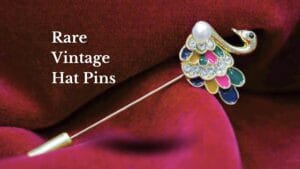You’ve probably seen them a hundred times – those long, ornate vintage hat pins with fancy tops sitting in antique shop display cases or flea market displays. Maybe you’ve even picked one up, wondering what the heck it was actually for.
So, let me tell you that these “random old pins” are actually vintage hat pins, and some of them are worth serious money. And I’m talking thousands, here!
But most people still don’t know how to spot valuable antique hat pins! And that’s where I’m going to help you with this guide. By the time you finish it, you’ll know exactly how to identify authentic hat pins, avoid expensive fakes, and find valuable gems.
What is a Hatpin?
A hatpin is basically a long, decorative pin that women used to keep their hats from flying off. Back when elaborate hats were the norm, these pins were essential – and they had to be both functional and beautiful.
It typically has two key parts: the decorative head, where all the artistry happens, and the shank, the long, sharp pin part. Although not a part, the finding (or the connecting piece that joins the head to the shank) is another important thing to observe, as it may bear tiny tool marks from the original manufacturing.
Identifying a Real Antique Hatpin? (3 Key Signs)
Now, when it comes to spotting an authentic antique hatpin from a huge collection, you need to focus on certain signs like its shape, size, construction, and markings. Let me break down these signs for you!
Materials
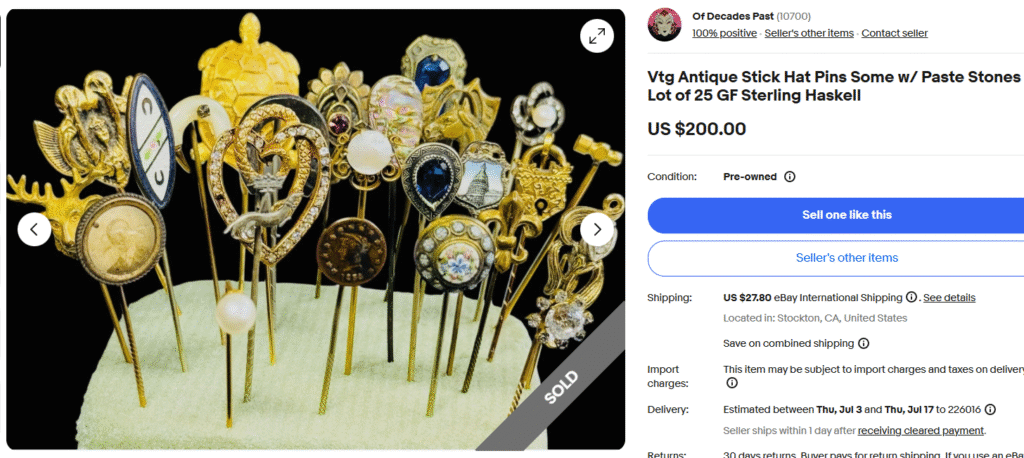
What hatpins were made from tells you a lot about when they were created and whether they’re antique or not. Here’s how:
Base Materials (For Shank & Head)
- Metals were the backbone of most hatpins. Steel and brass were the most common materials – brass was often gilded or plated to look fancier. Sterling silver and gold were for the high-end pieces. Cut steel was huge during the Victorian era – they’d rivet tiny steel studs together to create this amazing glittering effect to spot them!
- Early Plastics started appearing in the late 1800s. Celluloid was the earliest plastic for pins. But beware, it could fake ivory or tortoiseshell pretty convincingly. Bakelite came later and was perfect for those bold Art Deco designs with bright colors and sharp geometric shapes.
Decorative Elements
- Gemstones and Paste gave hatpins their sparkle. Real gems like amethyst, garnet, peridot, and seed pearls were used when money was no object. But “paste” stones were just as popular – these were high-quality cut glass made to look like the real gems, and hence, valuable.
- Glass came in every variety you can imagine. Pressed glass, molded glass, art glass, like that iridescent carnival glass, blown glass, lampwork glass. Micro-mosaic glass (tiny glass pieces arranged into scenes) was particularly fancy.
- Porcelain and Ceramic brought color and artistry to hatpin heads. Hand-painted porcelain was beautiful, and Satsuma ware from Japan became really popular, especially pieces made specifically for Western buyers who couldn’t get enough of that exotic look.
- Natural Materials were everywhere. Ivory, horn, bone, amber, mother-of-pearl, tortoiseshell, and jet (that’s fossilized wood, often used for mourning jewelry) all found their way onto hatpins. Each material had its own appeal and price point.
Period-Specific Styles
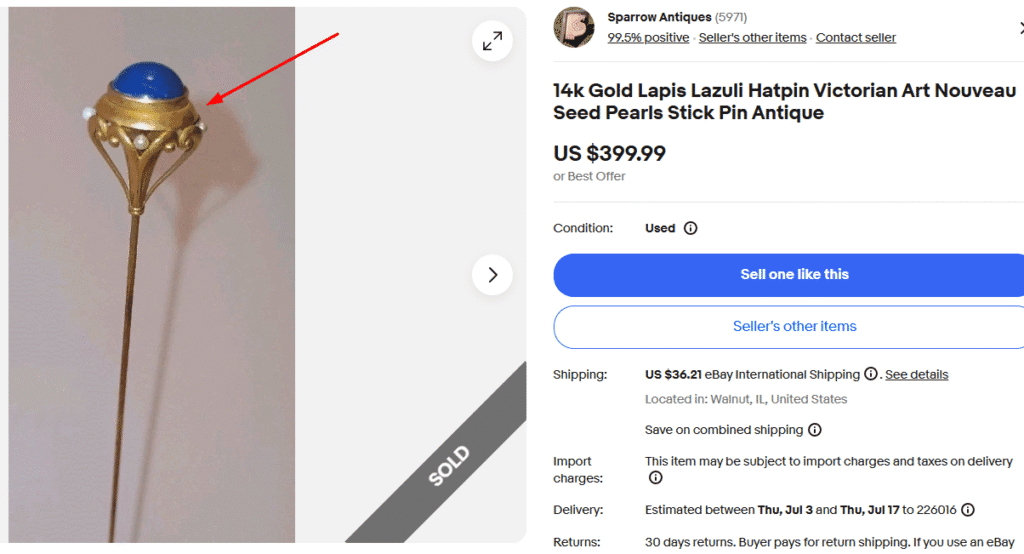
Vintage hatpins from each era had their own look, and knowing these styles will help you date pieces accurately.
- Victorian Pins (1837-1901): Victorian pins are known for their symbolism and elaborate decoration. Early pieces were handmade with romantic motifs. Later Victorian examples show more machine production but still maintain that over-the-board Victorian flair. These generally measure 6 to 10 inches!
- Art Nouveau Pins (1890-1915): These are some of the most beautiful hat pins you’ll find. You can spot these by flowing, natural motifs like flowers, dragonflies, and female figures. Most pieces were crafted in silver and featured that distinctive “whiplash” curve that defines Art Nouveau style.
- Edwardian Pins (1901-1914): Edwardian hatpins were light and airy with bows, swags, garlands, ribbons, and romantic motifs. You’ll mostly find platinum, diamonds, pearls, and white materials on these. The craftsmanship is incredibly delicate – almost lace-like! Also, this era saw the rise of long pins, almost 10-12 inches!
- Art Deco Hatpins: (1920s-1930s): These pieces are totally different from earlier styles, often with sharp geometric lines, bold symmetry, and a modern elegance. You’ll find chrome, Bakelite, celluloid, and rhinestones in striking colors. Another defining feature is that they’re much shorter, about 3-6 inches (for cloche hats).
Markings
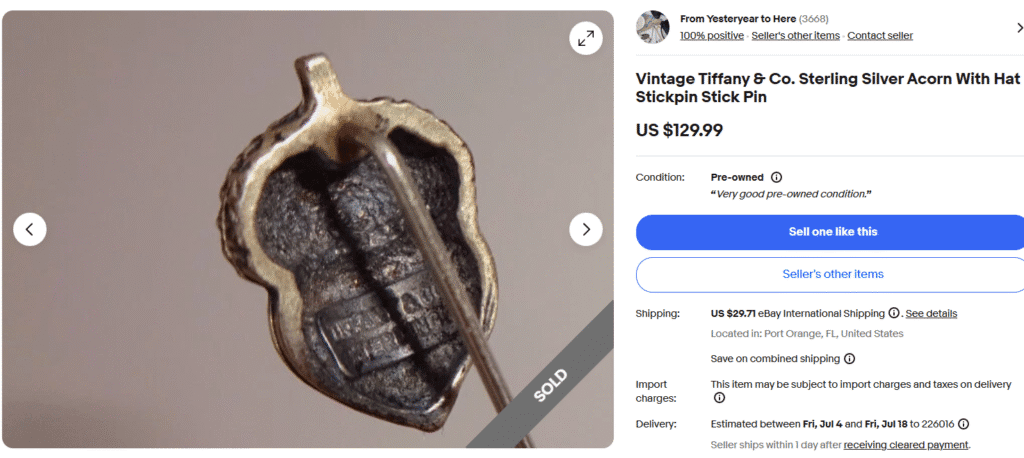
Most vintage hat pins aren’t really marked, which makes finding marked pieces extra special. You may find a company’s full name, its logo, or initials. These marks are mostly located on the shank, collar, and on the back of the head (if it has a metal frame).
Apart from maker’s marks, authentic pins made of precious metal like Sterling Silver, gold, or plated silver mostly bear hallmarks.
Construction Clues
This is what helps you catch fakes, but you’ll need a magnifying glass! Examine how the head attaches to the shank and look for the following clues:
Signs of Authentic Hand-Forged Work on Shanks
Early Victorian pieces often show clear signs of hand-forging that you won’t find on machine-made pieces. For instance, you’ll see slight irregularities in the shank (it might not be perfectly round or uniform), tiny hammer marks, or subtle variations on the surface
Signs of the Fitting (Finding)
Authentic findings are usually crimped onto the shank, creating a secure, professional joint. Run your finger over the connection – it should feel smooth and intentional. If you see a head that’s just glued on or held with a messy blob of solder instead of a proper finding, it’s likely a fake.
Also, real antique hatpins should have just one neat finding. If there are multiple pieces trying to hide the joint, that’s a later model or a fake.
Shank Material and Finish
Period shanks were almost always steel or brass, sometimes plated with nickel, silver, or gold. You won’t find tin, copper, or pewter used for shanks as they just weren’t strong enough.
Also, stainless steel didn’t really show up until the 1900s! So if you see a “Victorian” hatpin with a stainless steel shank, you know it’s not authentic.
Another important thing to note is that the hat pin makers always maintained consistent finishing standards across the entire piece. So, the head and shank finishes of real pins feel similar. If you see a beautifully gold-plated head attached to a dull shank, it’s not really real.
Stone Setting
Any rhinestones, pearls, or genuine stones should be set using period-appropriate methods – either bezel settings or prong settings. Modern glue-on stones are key indicators of reproductions.
What Makes Old Hat Pins Valuable? (5 Key Factors)
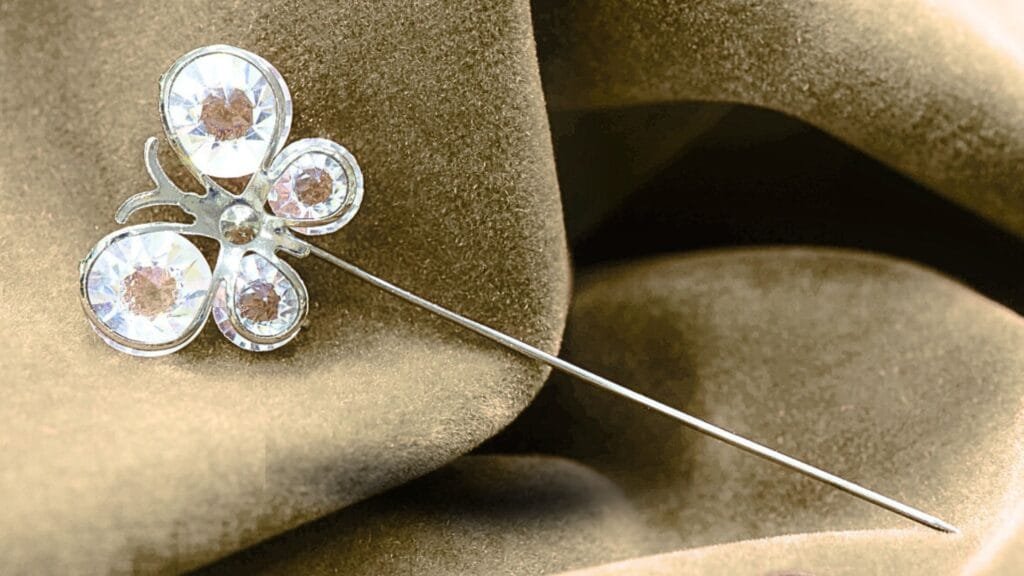
The value of an antique hatpin can range anywhere from $50 to a whopping $5,000! So, how can you differentiate between a low-value hat pin and the real gem? Here’s a breakdown of the key factors that impact a vintage pin’s value:
Length & Size
What most people don’t know about old pins is that their size also impacts the value. Here’s how:
Rare pins with extreme lengths are collectible for their historical context. Pieces over 12 inches long, especially from the Edwardian era, are rarer and more sought after, even if they’re not practical today. Pins under 6 inches? They’re not as desirable as true “hat pins!”
Secondly, elaborate heads bring more money. Larger, more intricate, and artistically significant heads tend to be worth more than simple, small designs. The head is where most of the artistry lives, so it makes sense that’s where the value is, too.
Rarity & Uniqueness
Since there are tons of old pins, rarity is one of the most important value factors to separate real gems from junk. Rarer vintage hat pins usually fetch higher premiums than common pieces. But what makes a pin rare?
- Unusual Designs: One-of-a-kind or really unusual stick pans will always beat mass-produced styles in terms of desirability and value. This include unique designs, rare stones, exotic gems, and natural materials. If you’ve never seen anything like it before, that’s a good sign.
- Limited Production: Hatpins from short-lived fashion trends or made by well-known but small manufacturers are harder to find, which drives up value. Pins made in a limited number for special occasions are also quite rare.
- Historical Significance: Pins with documented historical connections or those tied to social movements (like suffragette pins) are highly sought after by collectors. Plus, documented history adds serious value. Any documentation that can prove who owned it, or if it’s been in exhibitions or collections, can boost its price.
Condition
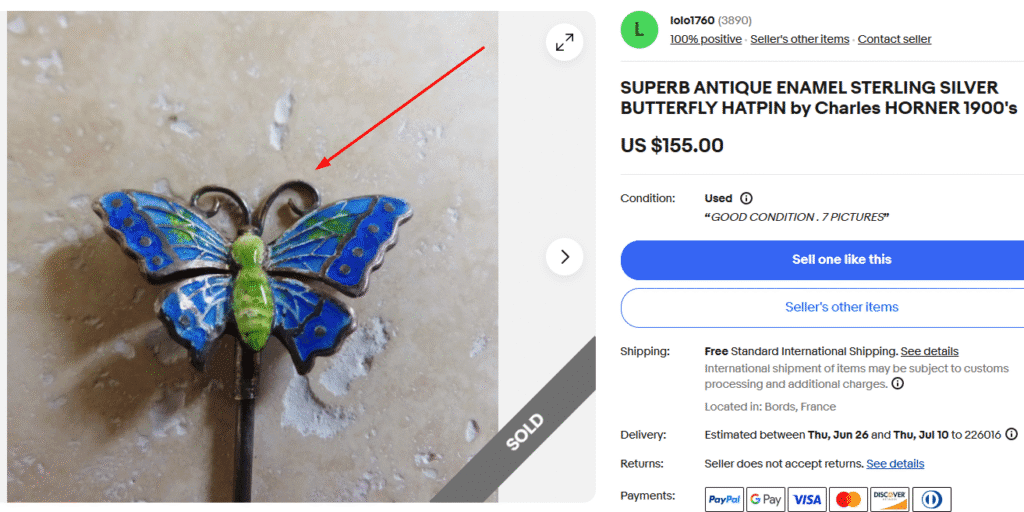
The truth about vintage jewelry is that even the most expensive pieces lose their worth if they’re damaged, and hat pins are no exception. So, here’s what to check:
If the pin still looks like it was made yesterday with no damage, repairs, or missing pieces, you’re looking at a pristine piece worth top dollar.
Minor wear, like light surface scratches, gentle patina, or slight dulling from age, is usually okay and expected. However, serious damage, including chips, cracks, missing stones, broken findings, or obvious fixes like glue or messy solder work, and repairs are value killers.
Also, originality is quite crucial. All the parts – head, shank, finding – need to be original and belong together. “Married” pieces made from different hatpins are much less valuable.
Materials
The material of the pin isn’t just an identification factor, but it also plays a huge role in its value. Here’s how:
- Precious metals and gemstones naturally command higher prices. Solid gold, platinum, or sterling silver, especially with real diamonds, rubies, sapphires, or other valuable stones, are the real gems.
- High-quality glass and enamel can also be surprisingly valuable. Intricately cut glass, art glass from famous studios like Tiffany or Loetz, or exceptional enamel work are highly prized by collectors.
- Rare or unique materials like genuine amber, carved ivory (though there are ethical considerations now), or specific types of antique porcelain can fetch premium prices.
Completeness
Finding hat pins that were originally part of a set (perhaps with a matching buckle or brooch) is rare and collectible.
The original box or holder is also a nice bonus. Period-appropriate presentation boxes or hatpin holders add to the overall appeal and value.
10 Rare Antique Hat Pins Worth Finding Now!
Let’s take a look at some rare antique hatpin examples that have actually sold for hundreds to thousands!
1. Vintage Loetz Hat Pin
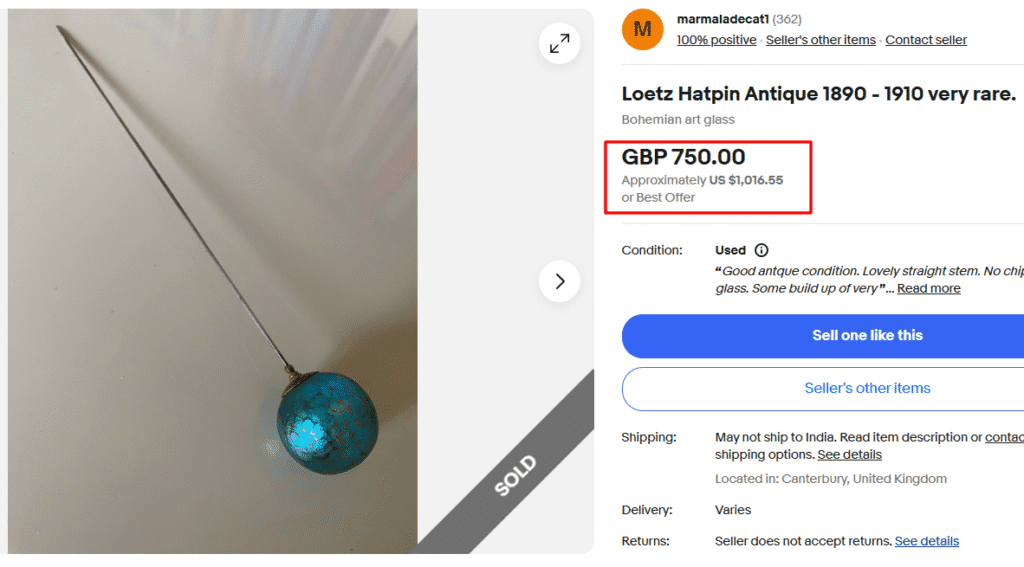
Finding a real branded antique hat pins is a big deal and this pin is one of them! It’s a Loetz pin featuring the unique blue iridescent glass ball (covered with vapors of metals) as the head, with a magical rainbow shimmer that Loetz was famous for. Besides, the “925” marked collar confirms its authenticity!
Loetz was the premier Bohemian art glass manufacturer during the Art Nouveau period (from roughly 1890 to 1920). The company became known for its innovative techniques, organic forms, and bold use of color. As a true example of Loetz, this pin can range from $800 to $1,500! This specific piece sold for GBP 750, which is around $1,016!
2. Rare Labradorite Dog Head Hat Pin
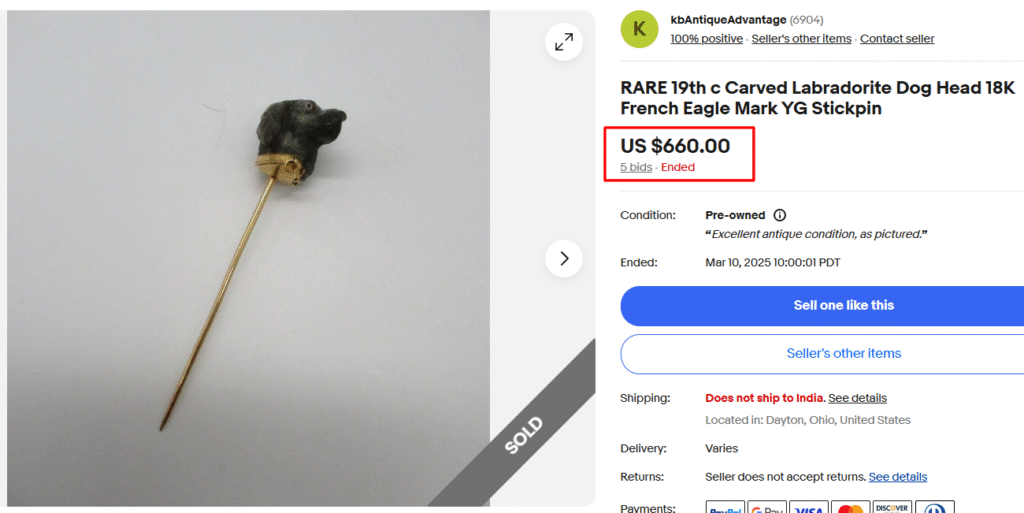
Hat pins with unique and artistic heads like this example are a collector’s charm! It’s a French piece that features a head made of labradorite carved as a detailed and lifelike dog head. Labradorite is a unique stone known for its iridescent play of colors; that’s why labradorite pins are collectible.
What further boosts the value is the French eagle’s head hallmark, which means a minimum fineness of 18k gold! A perfect combination of precious metal, stone, and artistry, this pin is rightly sold for $660!
3. Vintage Blackamoor Bronze Diamond Stick/Hat Pin
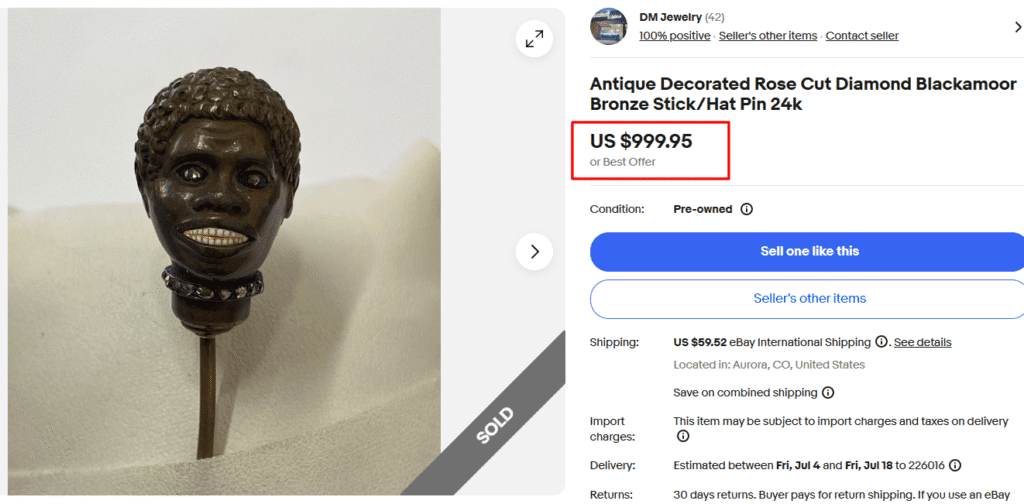
Now this pin is really historical! It’s a solid bronze pin with its headpiece shaped like a Blackamoor face with incredible detail, especially in expressive features. Blackamoors have a long history in decorative art, stretching all the way back to 17th century Italy, making this pin a vital piece of history!
What further boosts the value are the rose-cut diamonds in the eyes and around the neck. Such pins were considered “treasured” pieces during the Victorian period, and can sell for $500-$1,000 today!
4. Victorian Vanity Compact Hat Pin
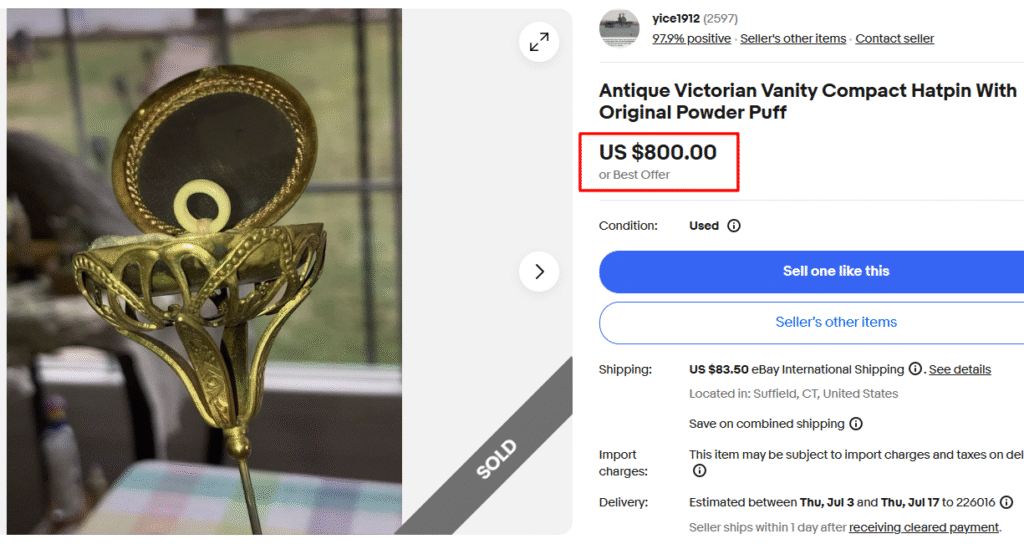
Unique hat pin designs are always the star of the show, just like this one! It’s a beautiful hatpin, with a head that actually opens up into a tiny compact with a mirror! Besides, the intricate swirling gold patterns are classic Victorian style, all ornate and fancy.
This specific pin can be even more special if it has the original powder puff inside, like this example! These combination pieces were genius – they looked elegant but were super functional. But not a lot of such pieces were made, making them quite rare today!
5. 1920 Labradorite Diamond Gold Monkey Head Hatpin
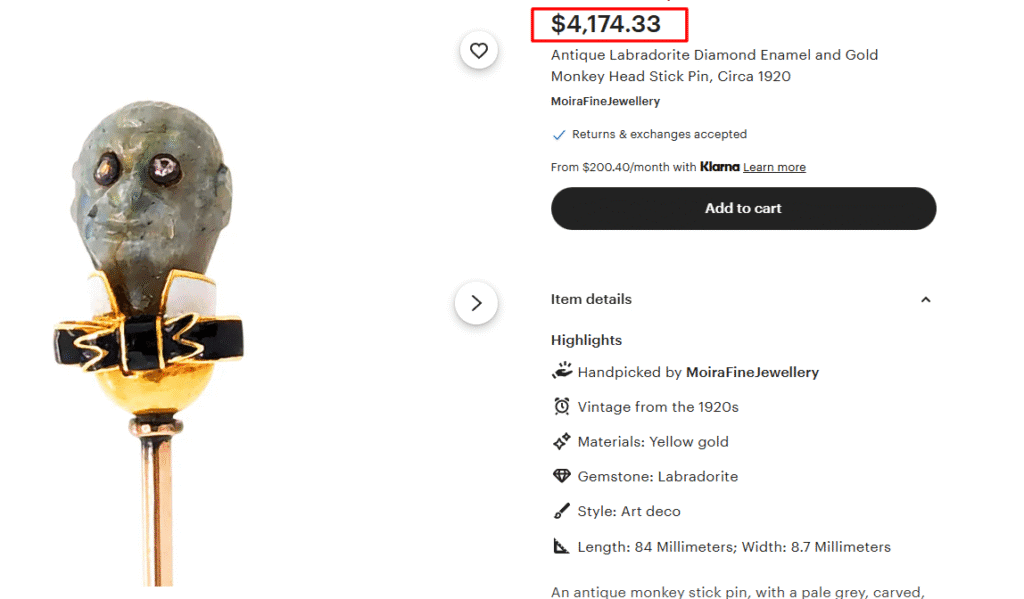
Another exotic example of a labradorite pin, this one has a detailed monkey head carved on the stone with rose-cut diamond eyes! The stones are set in rub-over settings, with a white enamel collar and black enamel bow tie, on a gold hemisphere!
This 1920s piece is a true example of the Art Deco era’s whimsical, exotic designs. The additional craftsmanship in the enamel work and diamond decoration is what makes this pin worth thousands!
6. Riker Brothers 14K Gold Winged Griffin Hat Pin
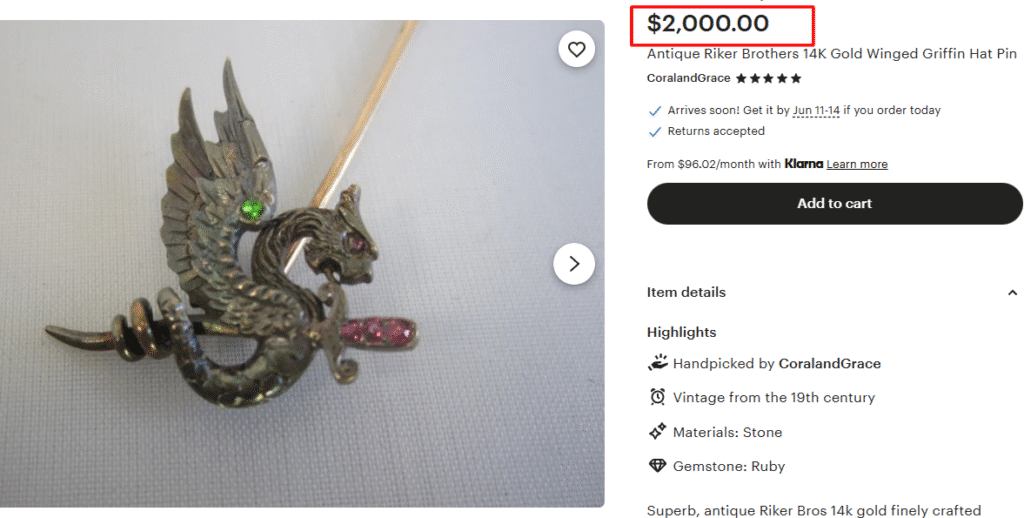
This is an exotic Riker Brothers griffin gold hatpin, a reflection of the iconic serpent jewels they popularized in the late Victorian period. The head is a magnificent winged griffin wrapped around a sword. The pin is made of 14kt gold with four small diamonds on sword’s handle!
This piece likely dates back to the 19th century, based on the serpent designs and the type of clasp on the back! Riker designs portraying dragons, griffins, basilisks, and other mythical creatures were quite popular in the late 19th Century.
7. Victorian 14k Gold Natural Coral Claw Hat Pin
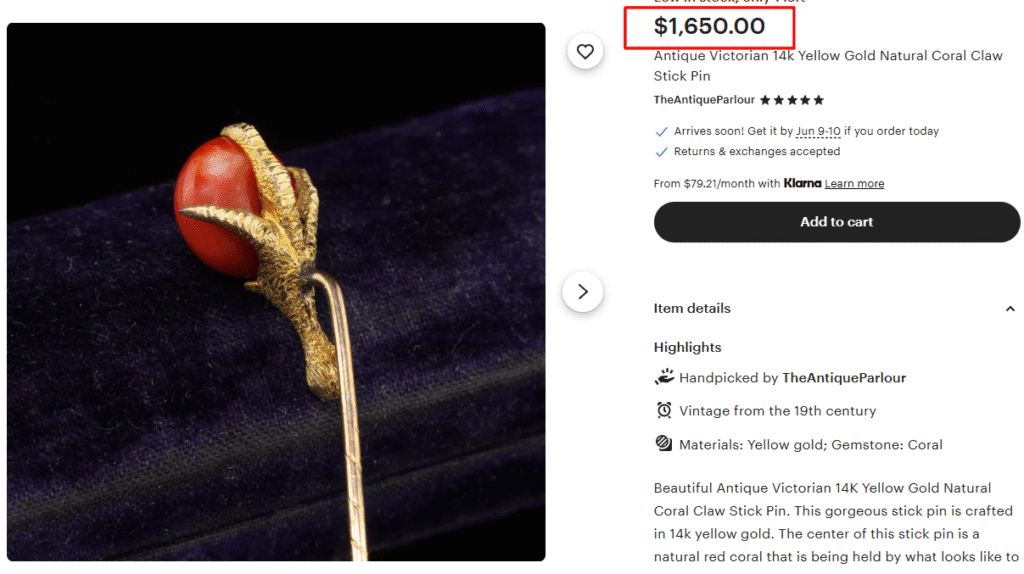
This gorgeous Victorian hat pin is made of 14k yellow gold, which already justifies its high price tag of $1,650. But that’s not it! The center of this stick pin is a natural red coral held by what looks like an eagle’s claw.
Natural coral was a big deal back then, both for its gorgeous color and because people thought it had protective powers, making it collectible. Besides, the goldwork is incredible -you can actually see the texture work on each gold talon!
8. Satsuma Geisha Fall Leaves Porcelain Ball Hatpin

If you thought hatpins were only made of glass and metal, look at this one! It’s a distinctive Japanese hat pin from the Meiji period (1868 to 1912) with a stunning porcelain ball head decorated with geishas and fall foliage in the classic Satsuma style.
One of the more distinctive features of this Satsuma is the crackled glaze and the overall painted decoration. Besides, Moriage, a Japanese word that translates as “heap up,” is a trailed-slip decoration originally used to indicate the gilt beading seen on Japanese pottery!
Such hand-painted pins are quite difficult to find today!
9. French Enamelled Frog Hatpin with Rhinestones & Faux Turquoise
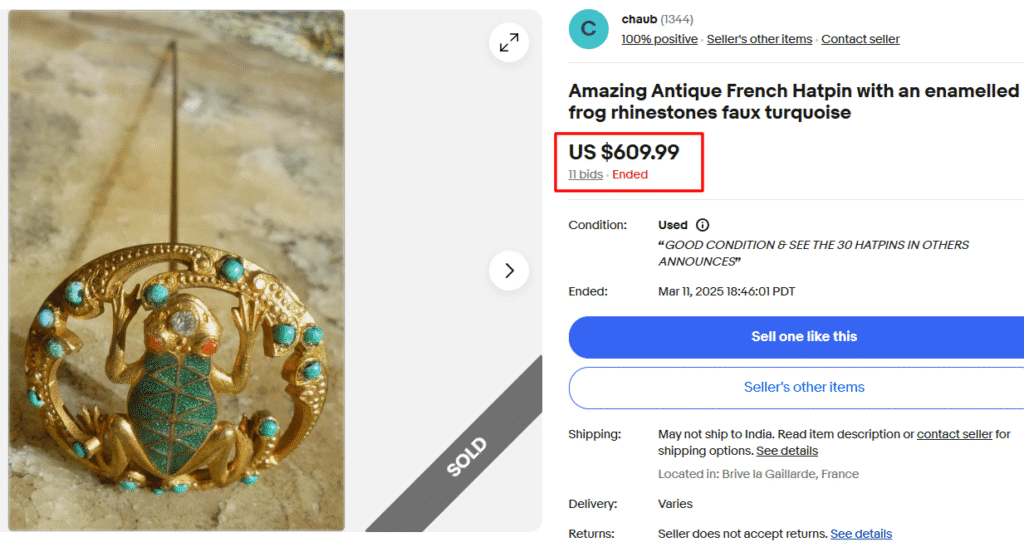
This antique French hatpin features quite an artistic head! It has a detailed circular hatpin head with an enameled frog surrounded by rhinestones and faux turquoise stones in a gold-toned setting. Although faux stones, this pin showcases superior craftsmanship, making it sell for over $600!
Vintage pins with such interesting and unique animal motifs are known as novelty pins. And novelty hatpins from the early 1900s are quite popular as collectibles! Besides, the detailed enamel work on the frog also makes this piece worth the money!
10. Art Nouveau Figural Lady Celestial Crescent Hat Pin
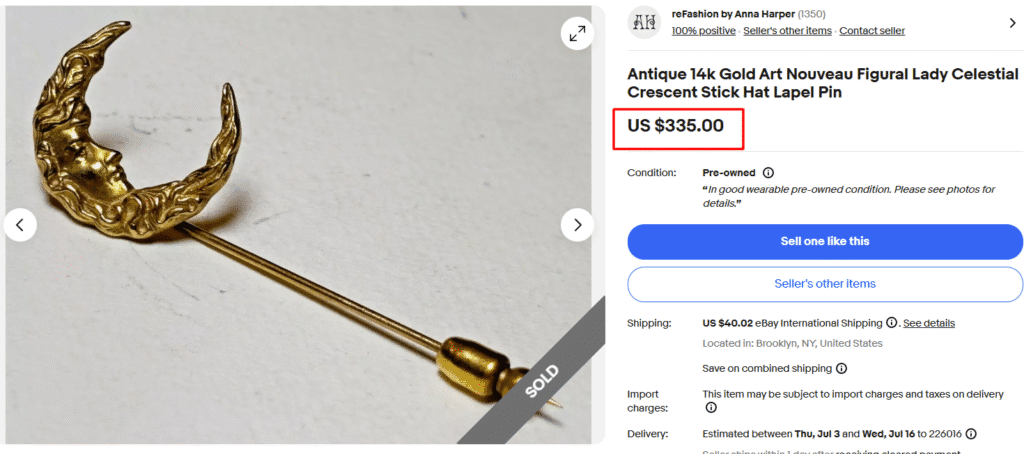
You know you’re looking at an Art Nouveau pin if it features a lady’s face or figure and flowing hair, just like this pin! Its head is designed as a crescent moon with a lady’s face nestled within it. The stick pin is crafted in 14k yellow gold, as hallmarked at the back!
These celestial motifs were incredibly popular during the Art Nouveau period when designers drew inspiration from mythology, astronomy, and feminine beauty. Such Nouveau pieces can be even more valuable if found with precious gemstones!
Note: This article is intended for informational, educational, and entertainment purposes only. Some images are illustrative and may not represent actual brands, products, or related entities. All trademarks, product names, brand logos, packaging, and other intellectual property referenced remain the exclusive property of their respective owners. Any brand mentions or references are provided solely for descriptive and educational context and do not imply any formal or commercial association.

